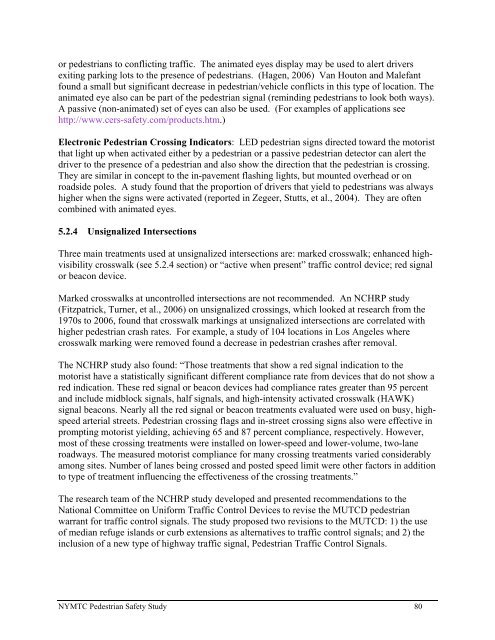NYMTC Regional Pedestrian Safety Study - New York Metropolitan ...
NYMTC Regional Pedestrian Safety Study - New York Metropolitan ...
NYMTC Regional Pedestrian Safety Study - New York Metropolitan ...
Create successful ePaper yourself
Turn your PDF publications into a flip-book with our unique Google optimized e-Paper software.
or pedestrians to conflicting traffic. The animated eyes display may be used to alert drivers<br />
exiting parking lots to the presence of pedestrians. (Hagen, 2006) Van Houton and Malefant<br />
found a small but significant decrease in pedestrian/vehicle conflicts in this type of location. The<br />
animated eye also can be part of the pedestrian signal (reminding pedestrians to look both ways).<br />
A passive (non-animated) set of eyes can also be used. (For examples of applications see<br />
http://www.cers-safety.com/products.htm.)<br />
Electronic <strong>Pedestrian</strong> Crossing Indicators: LED pedestrian signs directed toward the motorist<br />
that light up when activated either by a pedestrian or a passive pedestrian detector can alert the<br />
driver to the presence of a pedestrian and also show the direction that the pedestrian is crossing.<br />
They are similar in concept to the in-pavement flashing lights, but mounted overhead or on<br />
roadside poles. A study found that the proportion of drivers that yield to pedestrians was always<br />
higher when the signs were activated (reported in Zegeer, Stutts, et al., 2004). They are often<br />
combined with animated eyes.<br />
5.2.4 Unsignalized Intersections<br />
Three main treatments used at unsignalized intersections are: marked crosswalk; enhanced highvisibility<br />
crosswalk (see 5.2.4 section) or “active when present” traffic control device; red signal<br />
or beacon device.<br />
Marked crosswalks at uncontrolled intersections are not recommended. An NCHRP study<br />
(Fitzpatrick, Turner, et al., 2006) on unsignalized crossings, which looked at research from the<br />
1970s to 2006, found that crosswalk markings at unsignalized intersections are correlated with<br />
higher pedestrian crash rates. For example, a study of 104 locations in Los Angeles where<br />
crosswalk marking were removed found a decrease in pedestrian crashes after removal.<br />
The NCHRP study also found: “Those treatments that show a red signal indication to the<br />
motorist have a statistically significant different compliance rate from devices that do not show a<br />
red indication. These red signal or beacon devices had compliance rates greater than 95 percent<br />
and include midblock signals, half signals, and high-intensity activated crosswalk (HAWK)<br />
signal beacons. Nearly all the red signal or beacon treatments evaluated were used on busy, highspeed<br />
arterial streets. <strong>Pedestrian</strong> crossing flags and in-street crossing signs also were effective in<br />
prompting motorist yielding, achieving 65 and 87 percent compliance, respectively. However,<br />
most of these crossing treatments were installed on lower-speed and lower-volume, two-lane<br />
roadways. The measured motorist compliance for many crossing treatments varied considerably<br />
among sites. Number of lanes being crossed and posted speed limit were other factors in addition<br />
to type of treatment influencing the effectiveness of the crossing treatments.”<br />
The research team of the NCHRP study developed and presented recommendations to the<br />
National Committee on Uniform Traffic Control Devices to revise the MUTCD pedestrian<br />
warrant for traffic control signals. The study proposed two revisions to the MUTCD: 1) the use<br />
of median refuge islands or curb extensions as alternatives to traffic control signals; and 2) the<br />
inclusion of a new type of highway traffic signal, <strong>Pedestrian</strong> Traffic Control Signals.<br />
<strong>NYMTC</strong> <strong>Pedestrian</strong> <strong>Safety</strong> <strong>Study</strong> 80
















